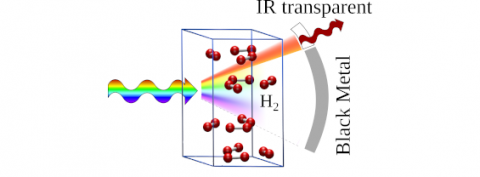The route for the room temperature superconductor

University of Rome “Sapienza” leads to the world challenge for hydrogen metallization. The results from a study published in Nature Physics
Rome, September 21st, 2020 – A research in theoretical physics, led by the University of Rome Sapienza, computed the physical and chemical properties of hydrogen at high-pressure: the vibrational spectrum, electric conductivity, color, and brightness. The results of the research have been published in Nature Physics when European countries like France and Germany just announced important investments in the field.
For decades, most important research groups all over the world are trying to compress hydrogen to create in the lab a room-temperature superconductor: a material that does not overheat and disperse energy when electricity flows inside it. A metallic state of hydrogen was hypothesized more than 80 years ago, and it is nowadays considered the holy grail of physics.
Metallic hydrogen probably forms in the nuclei of gas giant planets (as Jupiter and Saturn): making it in a lab is very challenging. Scientists must crush together hydrogen molecules up to very high pressures of about 500 GPa (gigapascal: one single gigapascal is equivalent to the pressure of an elephant over a tiny 1 € coin).
Recently, three experimental studies reported contradictory results: A Harvard research, published on Science in 2017, observed hydrogen turning black above 300 GPa and abruptly shiny at 500 GPa (a signature of metallization). A different study, published in 2019 on Nature Physics, measured the electric conductivity of the sample, showing that metallization occurs at only 360 GPa. Last but not least, a third study, published on Nature in early 2020, showed that hydrogen remains transparent if observed with infrared light up to 420 GPa, when suddenly becomes opaque. Each different research group claimed to be the first to reach hydrogen metallization and that other groups made errors in the measurements.
Lorenzo Monacelli, from the Physics Department of University of Rome “Sapienza” and first author of the work, says: «We employed a very advanced theoretical model we developed to simulate hydrogen at high pressures. Our aim was to disclose possible mistakes in the experiments and to shed light on how hydrogen metallizes.».
The theoretical physicist further explains: «We were astonished when our results confirmed the experimental data of all the three research groups. Metallic hydrogen is a unique material: not only it is a black metal (as graphite), but it is even transparent to the infrared light even it conducts electricity».
The article
The article, entitled “Black metal hydrogen above 360 GPa driven by proton quantum fluctuations”, has been written by Lorenzo Monacelli and Francesco Mauri (University Sapienza, Rome), Matteo Calandra (University of Trento), and Ion Errea (University of the Basque country). It has been published on September 7th, 2020, on Nature Physics.
The paper can be read on https://www.nature.com/articles/s41567-020-1009-3
(DOI: 10.1038/s41567-020-1009-3)
